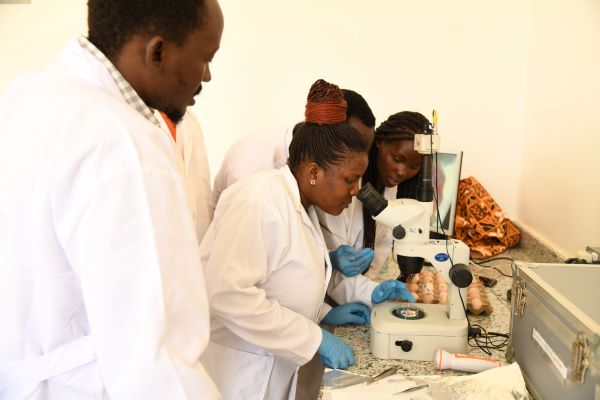Farmers from the eastern and central Africa have nothing to worry about their valued Africa indigenous chicken which has constantly faced extinction threats due to disease, genetic problems, breeding cessation, or natural disasters.
This follows a training by the International Livestock Research Institute (ILRI) offered to twenty-five scientists from the region on how to identify, isolate, conserve and improve poultry genetic resources being the key measures in protecting and enhancing the value of Africa’s indigenous chickens.
The avian reproductive biotechnology training at the National Animal Genetic Resource Centre and Data Bank (NAGRC&DB) in Entebbe, Uganda, targeted experts in poultry biotechnology, breeding and conservation; managers of the regional African Union animal resources seed centres of excellence (AU-ARSCoEs), academics and poultry stakeholders.
Supporting future breeding
The 4–9 September training is part of the ‘Biobanking of indigenous chicken breeds’ project that is preserving African and southeast Asian indigenous poultry biodiversity for subsequent use to enhance resilience, productivity and support future breeding of the tropical poultry strains.
Most indigenous chicken genetic resources are maintained in situ in living populations (the preservation of species and populations of living organisms in a natural state in the habitat where they naturally occur), which exposes them to risk of loss due to disease, genetic problems, breeding cessation, or natural disasters.
The periodic reproduction of in situ populations also makes indigenous chicken costly to maintain, and requires special facilities including poultry houses and farms, and human resources.
“Preserving biological materials in birds has primarily relied on the utilization of semen, thereby hindering the conservation of certain crucial genetic elements. Additionally, the unique structure of avian eggs poses a challenge, as it restricts the preservation of ova and fertilized embryos, in contrast to the methods employed for mammalian species,” said Christian Tiambo a scientist at ILRI who was also one of the trainers.
Tackling the challenge
To tackle this obstacle, it is possible to extract avian primordial germ cells (PGCs), the initial population of germ cells established during early development, and then reintegrate them into recipient embryos.
“Avian PGC transplantation technology allows for the preservation of the complete genetic makeup of the avian stock, facilitating the conservation of avian genetic diversity without the need to relocate genetic material from their original regions or countries,” added Tiambo.
Efficiently isolating and cultivating chicken PGCs in vitro also serves as a valuable system for researching the biology of indigenous and regionally adapted chicken ecotypes.
Africa’s animal genetic resources
Mary Mbole Kariuki, a technology and innovation specialist at the African Union-InterAfrican Bureau of Animal Resources (AU-IBAR), emphasized that Africa possesses the most extensive array of animal genetic resources, underscoring the necessity for their preservation.
She underscored the significance of indigenous animal genetics for sustaining livelihoods and stressed the importance of safeguarding breeds that are well-suited to the African environment.
Sharing successful experiences is a key solution for livestock sector challenges. South-South knowledge exchange can enhance sustainability in livestock production by sharing information, strengthening the capabilities of experts, and promoting the expansion of successful solutions.
The six-day training comprised two days of stem cell biobanking lectures and four days of hands-on laboratory sessions using Ugandan chicken ecotype eggs. Additionally, participants visited NAGRIC&DB, an AU-IBAR regional animal resources seed center of excellence.
Role of biobanking
Jackson Mubiru, head of assisted animal reproductive technologies at NAGRC&DB, stressed the vital role of biobanking in conserving poultry breeds for research purposes, particularly in enhancing disease resistance and productivity.
Ben Lukuyu, a senior scientist and ILRI Uganda’s country representative, shared ILRI’s regional research findings, highlighting the significant impact of improved genetics on household incomes and livelihoods.
He pointed out that ILRI’s work in the Ugandan pig sector demonstrated that smallholder farmers can increase their incomes by accessing more productive breeds.
Given the rapid growth of the poultry sector in Uganda, which sees breeds from around the world, it presents both research and industry opportunities for enhancing smallholder livestock farming while safeguarding local breeds.
Knowledge support
The training is building a community of practice that will support knowledge transfer and national agricultural research services in livestock development, using stem cell biobanking in Africa.
Materials used during the training were biobanked and the conservation actions started at the event will be extended and implemented by the trainees in their respective countries.
Training outcomes will be used to advocate for development of local poultry conservation programs in eastern Africa and their related value chain for better livelihoods.
Reproductive and surrogate technologies
The September ‘East Africa training workshop on reproductive and surrogate technologies for biobanking and restoration of indigenous chicken genetic resources’ was the first regional training organized within the avian reproductive and surrogate biotechnology in sub-Saharan Africa framework, a partnership initiative on South-South Cooperation.
The framework is supported by ILRI, the Centre for Tropical Livestock Genetic and Health (CTLGH) through their Poultry Cellular Resources, Functional Genomics Tools and Biotechnologies Unit.
Other collaborators include the African Union Development Agency-NEPAD, AU-IBAR through the regional Animal Resources Seed Centres of Excellence and the host institution, NAGRIC&DB. Participants were drawn from from Kenya, Ethiopia, Tanzania, Rwanda, Burundi, Cameroon and Uganda.








